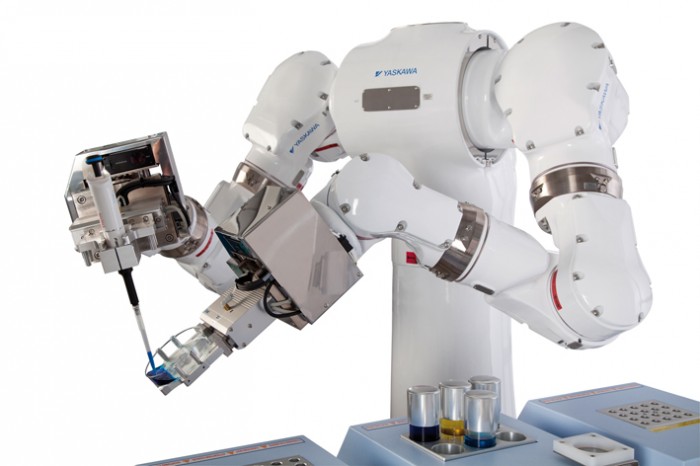YASKAWA’s dual arm robot CSDA10F shown at Analytica 2014

YASKAWA dual arm robot in pharmaceutical research
Photo by yaskawa
Robot manufacturer Yaskawa presented an impressive innovation for the life sciences sector at Analytica: in a live demonstration cell, a dual arm robot with a human-like stature and two hands performs the complex preparation of samples and operates analytical instruments.
With their unprecedented performance in terms of precision and repeatability, robots have now made their way into the field of life sciences: they automatically carry out synthesis and analytical tasks in pharmaceutical research and development – in areas where conventional automation was previously too inflexible and too expensive.
Yaskawa, the world’s leading manufacturers of industrial robots, presented the CSDA10F dual arm robot to the European public for the first time at Analytica. This industrial robot has been specially designed to meet the hygiene requirements of laboratory environments. Initial installations in the fields of biomedical synthesis (cancer drug development) and analytical chemistry (preparation of samples) have shown that this robot is able to work with virtually all available standard laboratory equipment and conventional analytical instruments that can be found in manual workstations, such as Petri dishes, manual pipettes, incubators, Eppendorf tubes, etc. This means that automatic analytical instruments with specialised liquid handing systems and expensive consumables are not required.
The robot is extremely suitable to carry out standardised test procedures, but thanks to its flexibility can learn entirely new work sequences quickly and easily. The robot is also an interesting solution for process development, e.g. for the definition, validation and optimisation of process steps prior to scaling up the throughput of automated production.
Comparative studies from the field of biomedicine in Japan have indicated that the quality and reproducibility of the work results of a robot are not only considerably superior to those of a laboratory assistant, but even create new conditions for research on substances that could not, until now, be produced with sufficient process reliability or consistency. That is the reason why such robots have already been used for pharmaceutical research in Japan, the birthplace of robotics, for well over two years.
The robot itself is almost maintenance free and easy to operate. Many typical motions (pipetting, opening/closing Eppendorf tubes, handling a microtiter plate, opening/closing an incubator, opening/closing screw caps of bottles) have been standardised and stored as modules in a motion library. The operator merely composes and parameterises the individual process steps for his desired work sequence with the aid of higher level scheduling software.
For more information, please visit http://www.motoman.eu.
News Categories
- » NEWS HOME
- » Automation & Robotics
- » Industry 4.0
- » Material Handling
- » Sensors
- » Quality & Testing
- » Machine Vision
- » Laser & Optics
- » Metalworking
- » Motion Control & Drives
- » Hydraulics & Pneumatics
- » Process Industry
- » Renewable Energy
- » Agriculture
- » Home & Office Furniture
- » Environmental Tech




